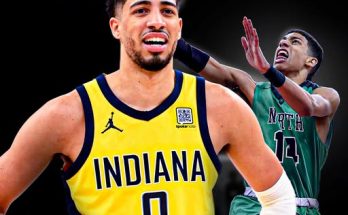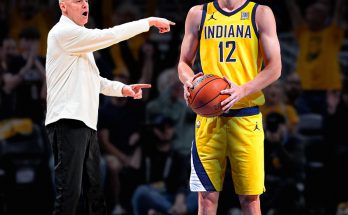From Bench Spark at Rocky Top to NBA Spotlight: Jordan Gainey’s Time Has Come.
For Jordan Gainey, the journey from being the reliable sixth man at Tennessee to now preparing for an NBA audition is not just a testament to patience and perseverance, but to belief in one’s craft and timing. The story isn’t flashy. It’s not about one-and-done headlines or early draft hype. Instead, it’s a story built on steady growth, resilience in the shadows, and the quiet fire that burns in players who are often overlooked until the spotlight finds them.
At Tennessee, Gainey found himself surrounded by elite talent. The Volunteers weren’t just good—they were deep. With All-SEC stars, seasoned veterans, and a loaded backcourt, cracking the starting lineup was more of a luxury than a requirement. Gainey embraced that sixth-man role with humility and purpose. While others might have grown frustrated or transferred out in search of more minutes and attention, he leaned into the identity the team needed him to have.
Coming off the bench didn’t mean he wasn’t essential. In fact, Gainey was often the spark that ignited the Volunteers during critical stretches of games. His presence off the bench brought scoring, energy, and stability. Whether Tennessee needed a defensive stop, a three-point bucket to break a drought, or a calm handle against pressing defenses, Gainey delivered. He became the glue guy—someone who might not stuff the stat sheet but made winning plays. Coaches noticed. Teammates respected it. Fans appreciated it. And now, the NBA is watching too.
The journey to this moment was never guaranteed. Gainey wasn’t a five-star recruit with offers pouring in. He didn’t enter college basketball with the same buzz as some of his peers. He had to carve out his space—first at USC Upstate, where he began his college career and turned heads with his shooting stroke and basketball IQ. There, he showed glimpses of what he could be: a knockdown shooter with a good feel for the game and a solid perimeter defender. That performance earned him a spot at Tennessee, where the stakes were higher and the spotlight brighter.
At Tennessee, Gainey didn’t immediately become the star of the show. But he grew into his role with quiet confidence. Under Rick Barnes, known for his structured system and demanding expectations, Gainey matured. He learned to play within a system, to prioritize team success over individual stats, and to capitalize on every minute he got. He understood that consistency would be his calling card, that his opportunity wouldn’t come from flash but from trust.
When NBA scouts evaluate players, they look beyond the surface. They know how to identify talent that fits into the league not just as stars but as contributors. Gainey fits that mold. He isn’t coming into the league as a franchise savior or a projected lottery pick. Instead, he’s positioning himself as a valuable rotation piece, a player who can space the floor, defend multiple positions, and provide maturity and effort every single night.
In a league increasingly reliant on shooting and positional versatility, Gainey’s skill set translates. His three-point shooting, particularly off the catch and in rhythm, is consistent. His footwork and shot preparation are tight. He doesn’t need the ball in his hands to be effective, which makes him a good fit alongside high-usage stars. On defense, he’s smart with positioning and uses his length well to disrupt passing lanes and contest shots. He might not be a lockdown defender, but he rarely makes mistakes—something NBA coaches value immensely.
What makes his transition to the NBA even more compelling is his mental makeup. Gainey has been through the grind. He’s had to prove himself at every level. He’s had to accept less glamorous roles and excel in them. That mindset—of doing whatever is asked to help the team win—is rare in a league where individuality often overshadows team success. NBA franchises love players who understand their role, buy into it, and execute without ego. Gainey checks that box.
Now, as he prepares for workouts, combines, and Summer League opportunities, Gainey understands what’s at stake. This is the window he’s been preparing for—one open through effort, patience, and consistent improvement. He’s not walking into these auditions asking to be handed anything. He’s bringing film, discipline, and a willingness to grind. He’s bringing every minute of tape from Tennessee where he locked in defensively, knocked down key shots, and celebrated his teammates’ success as loudly as his own.
For fans who watched him at Tennessee, this moment feels like overdue validation. They saw what he meant to the team. They witnessed his growth, the clutch plays, the sideline energy, the sacrifices. Now, they get to root for his leap to the next level. And if the NBA is as much about fit and role as it is about highlight reels and potential, Gainey stands a real chance to find a home.
Basketball careers often come down to moments—windows where preparation meets opportunity. For Jordan Gainey, that moment has arrived. And while it may not come with viral mixtapes or early mock draft chatter, it comes with something more powerful: a track record of doing the little things right, of making every possession count, and of understanding what it takes to win.
The league is filled with players who had to take the long road. Every year, someone who wasn’t projected high breaks through not because of flash, but because they simply fit. They do their job. They stay ready. They rise when it matters. Jordan Gainey has been doing that for years. Now, all he needs is the opportunity to do it on the biggest stage. His game speaks in actions, not hype. And that might be exactly what an NBA roster needs.
From Rocky Top to an NBA audition, Gainey’s story is a reminder that roles don’t define ceilings. It’s what you do with your role that matters. Gainey did it right—game by game, minute by minute. And now, the league is listening.



